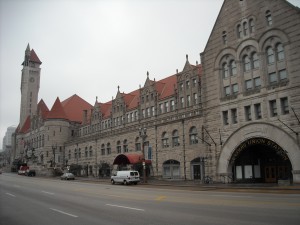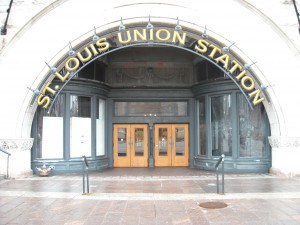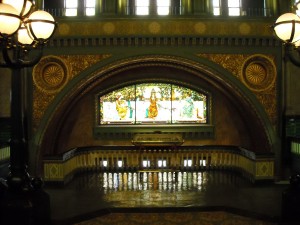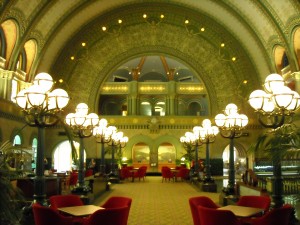When discussing famous St. Louis places it is difficult to imagine not including the historical St. Louis Union Station located at 1820 Market Street.

St. Louis Union Station
Once the largest and most beautiful passenger train terminal in the United States, this unforgettable St. Louis landmark is truly a site to behold with a fascinating story behind it’s conception.
You see, during the late 1800’s the city of St. Louis had become a major travel hub via passenger train from the east to the west coast of the United States. In 1889, Union Station was conceived by the Terminal Railroad Association to replace the older less adequate Union Station and consolidate the numerous railway entries and exits of the St. Louis area.
The Association hired a a former railroader and St. Louis architect by the name of Theodore C. Link to design the now famous structure. The goal was that it should be magnificently stunning and capable of impressing the rich and famous public figures who regularly traveled through the St. Louis area to get to their final destination within the United States.

front Market Street entrance
Theodore Link was paid $10,000 for his work which proved to be well worth it. His designs provided a Headhouse to contain the ticketing offices, a restaurant, waiting rooms, the terminal hotel and railroad personnel offices. In addition, the design included the famous Midway which provided a covered transfer area for the numerous train passengers family and friends to bid each other farewell and welcome incoming visitors. Part three of Theodore Links plan was The Train Shed which was a large roofed area to cover the loading platforms and tracks.
Money seemed to be no object for this enormous project and on September 1st, 1894 the new Union Station was opened to the public complete with a Grand Hall, archway entrances and exits, a 65 foot vaulted ceiling and stained glass windows. One of the most famous stained glass windows is the “Allegorical Window” which depicted the three main U.S. train stations during the late 1800’s – New York, St. Louis and San Francisco. It is said that the window is framed by the famous “Whispering Arch,” where a visitor’s whisper at one end of the arch can be heard at the other end nearly 40 feet away.

Famous "Allegorical Window"
In total the new and improved St. Louis Union Station cost $6.5 million from start to completion. Mr. Link had modeled it after Carcassone, a walled medieval city in Southern France and one can certainly tell by the exterior as well as interior architectural design.
The terminal would remain a hot spot for St. Louis over the next 40 years or so until the mid 1940’S. It was a small city in itself where over 100,000 passengers a day passed through on their way to different destinations. Visitors could do a bit of shopping or enjoy some fine dining at the famous Harvey’s Restaurant which Fred Harvey had established at many train terminals throughout the country including one at St. Louis Union Station.
By the end of World War II the general public began using alternative means of transportation for travel and in the late 1960’s only 14 trains a day were using the station. The grand St. Louis terminal had become quiet and somewhat of a ghost town. On October 31st, 1978 the last train pulled out of the station forever. The monumental terminal was designated a National Historic Landmark and sold for 5.5 million dollars in 1979.

Grand Hall inside St. Louis Union Station
In 1985 St. Louis Union Station received a 150 million dollar restoration and remains in it’s current state.
Today Union Station is a wonderful spot to visit with plenty of unique shops, fine dining, amazing architectural structures, a Marriott Hotel and loads of entertainment.
The station offers free guided tours by appointment.
For more information please visit:

